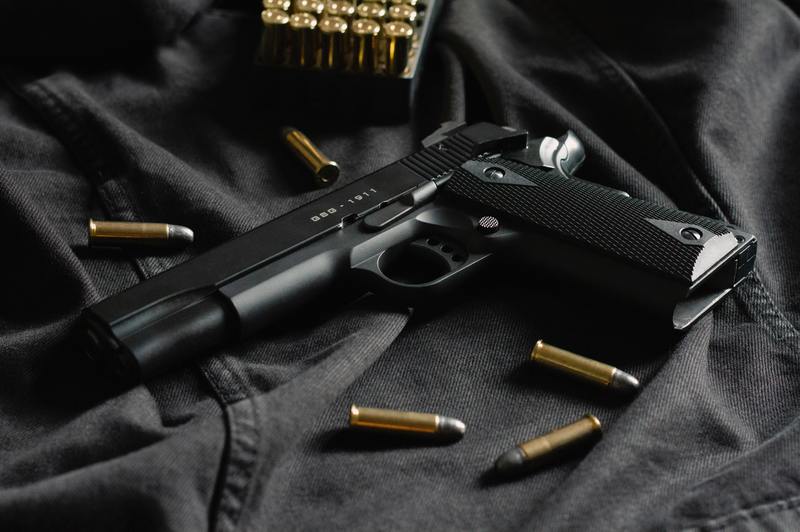A licensed gun owner ought to know how to fix a water damaged gun, as you never know what mishaps could happen involving your weapon. You’re going to have to take the firearm apart while adhering to safety protocols.
Let’s break it down for you.

Why Should You Avoid Getting Your Gun Wet?
It’s worth mentioning that even when a modern gun gets wet, it may still fire. However, you need to clean and dry the gun immediately before the liquid seeps into it.
If not, the firearm may sustain rust and other water damage.
First and foremost, you need to consider gunpowder if your gun relies on it. When a gun gets wet, the liquid could make its way to the gunpowder.
It goes without saying that wet gunpowder doesn’t ignite. In this case, the gun won’t be able to shoot.
Another thing to remember is that most of the parts of your firearm are metallic. Getting your gun wet can also entail rust accumulating within.
Rust can make loading or firing the gun much more difficult. Not only that, it can spell all kinds of bad news and resulting accidents.
For example, a rusty barrel may cause your gun to explode. The rust can also cause tiny pits to appear on the barrel and discolor it, causing rust to wreck your firearm.
Another material that comprises your gun is wood. Water-damaged wood can become brittle and cause your handle — if it’s made of wood — to crack or warp.
Given all this information, it’s crucial to deal with moisture immediately before it penetrates the inner parts. However, you may still encounter a water-damaged gun in extreme weather conditions, flooding, or other unforeseen events.
Now that you know what water damage could do to your gun, here’s a quick walkthrough on repairing the damage.
How To Go About Repairing The Gun?
Step #1. Remove all moisture
To get started, you have to ensure you excise all the moisture from the gun. Begin by taking apart the gun and wiping the parts with a clean towel or cloth.
Take note that this won’t take out all the moisture. You can get rid of any residual moisture with lubricants such as water displacing oil.
Soak the disassembled parts in the oil for a few minutes.
Also worth noting is that wooden parts hold in more moisture. When you finish submerging the components in the oil, allow the wooden pieces to air dry.
You may be wondering about water-damaged wooden parts, but don’t fret. Here are handy articles on how to fix water damaged woodwork and how to clean water damaged bare wood.
Unfortunately, any water-damaged ammunition that you soak in the oils is likely beyond repair. Better not take any chances, or a fatal accident might happen.
You’ll have to properly dispose of water-damaged ammunition. Even if you end up disposing of undamaged bullets, it’s better to err on the side of caution.
Step #2. Do “gun surgery”
Yeah, it sounds weird. However, gun surgery may be the most fitting way to describe this step.
With all your firearm parts free of residual moisture, you need to carefully study each piece for rust or other damages from the liquid. This process will entail some tools like wrenches, punches, or screwdriver bits.
You may find some parts won’t budge, but don’t worry. It could be attributed to rust from water damage. You need to be very meticulous about this to avoid further damage.
To deal with rust, simply apply oil and put in extra effort to scrub it away. Use steel wool or an all-purpose brush to clean off the rust.
Don’t go too hard, as you still want the metal bits to stay intact.
Step #3. Identify parts to replace
Some parts are likely to be too damaged to the point of no return. If you encounter such parts, then you have no choice; you need to get new ones.
You may be thinking there may be ways to salvage certain parts, but sometimes it saves money to get new ones altogether.
Visit your local gun manufacturers to pick out some new replacements for parts beyond repair.
Step #4. Add extra protection
When you get your gun back in good shape, you’ll want to ensure it doesn’t suffer more water damage in the future.
Lather the gun with substances such as oil, wax, or grease. You’ll want the coating to repel water and prevent further damage.
Oil may be much easier to apply. On the other hand, wax has more extended longevity on your gun and is the most water-resistant.
Moreover, grease is much thicker and will retain on your firearm better.
Conclusion
As we’ve established, you’ll want to avoid getting your firearm wet by any means necessary. While you might not be able to avoid it 100% of the time, you can figure out steps to go about repairs.
Knowing how to fix a water damaged gun can be helpful in the long run and save your firearm from the point of no return.
